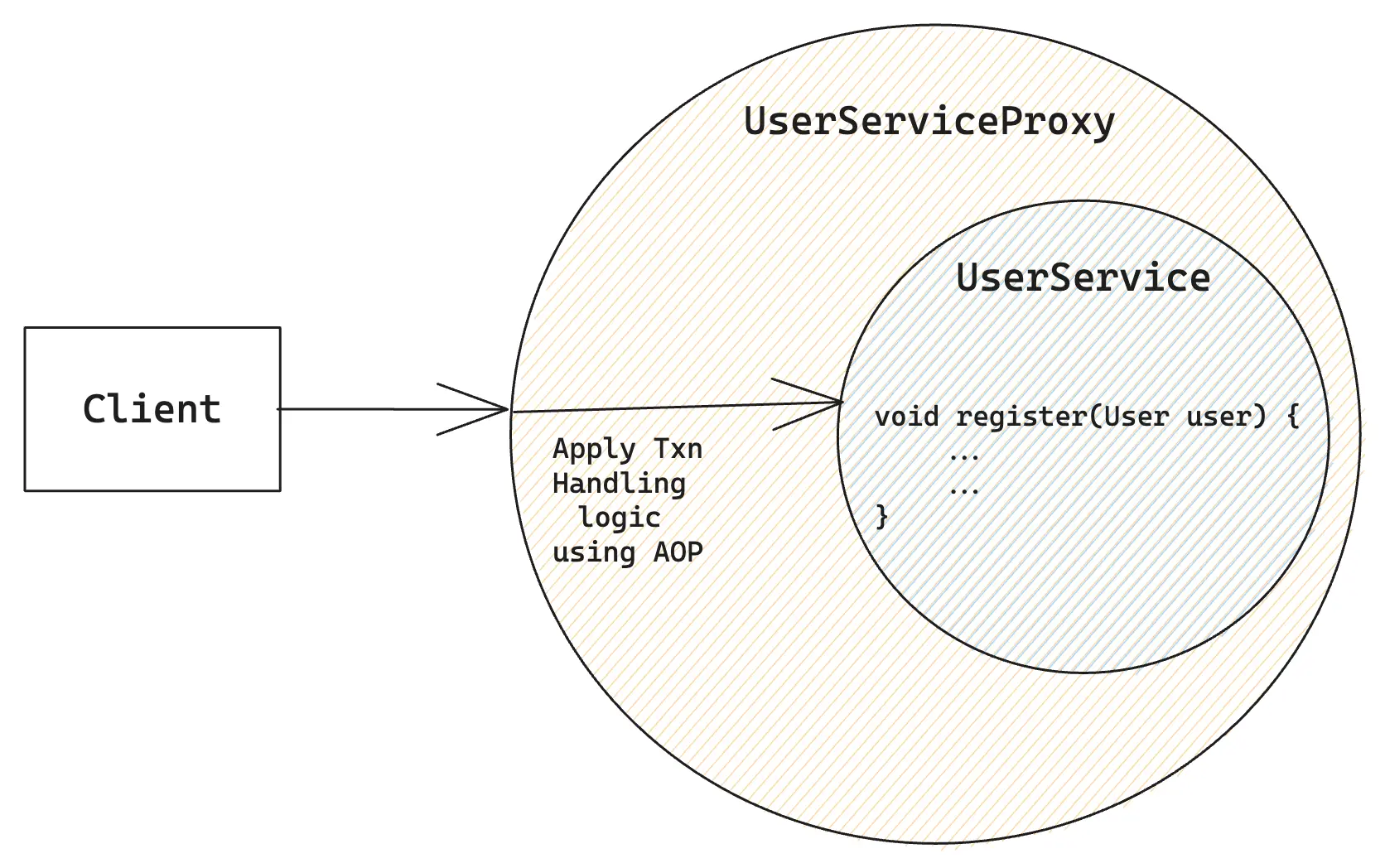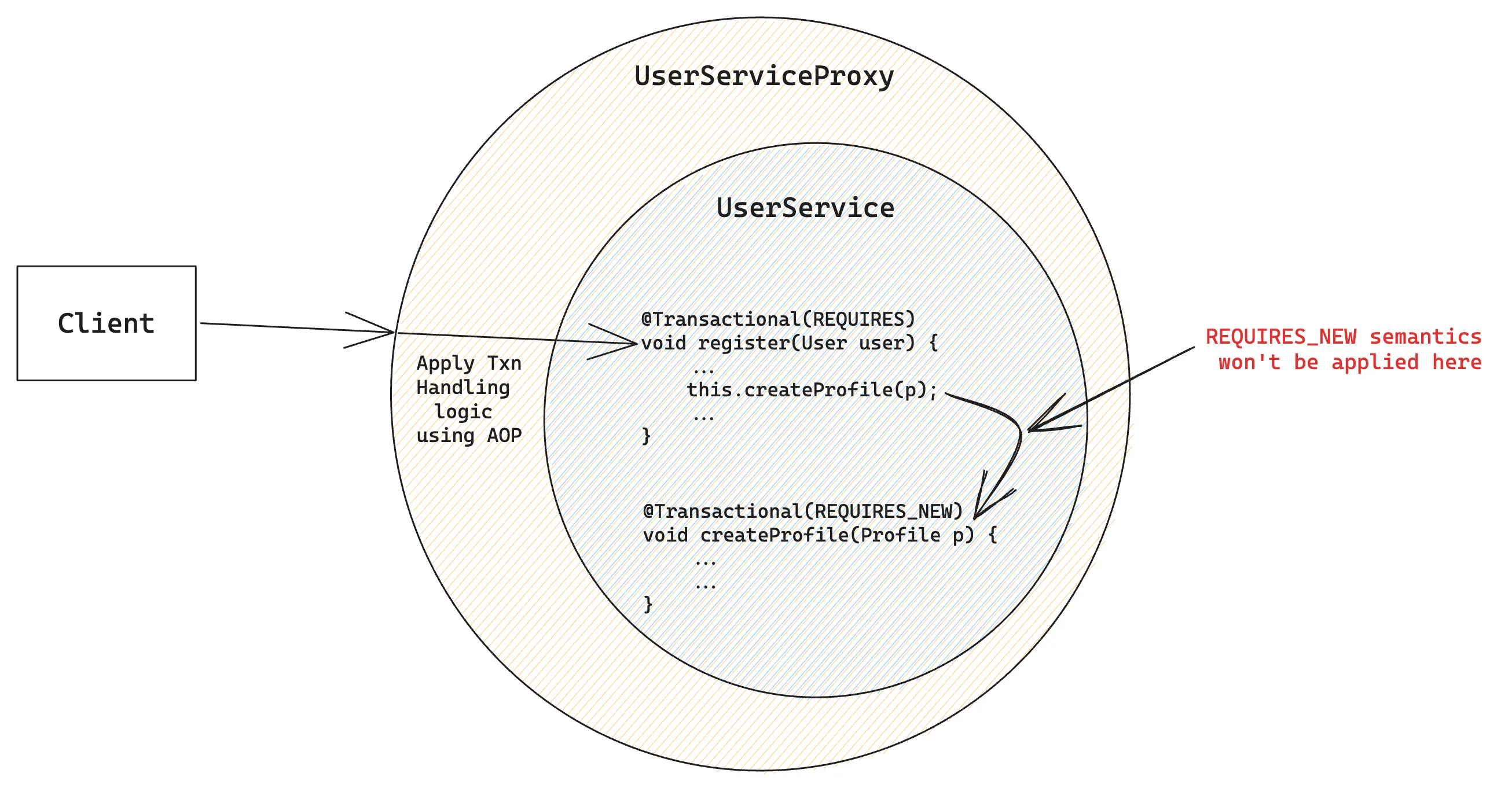Spring Boot Database Transaction Management Tutorial
Spring provides a high-level abstraction on top of JDBC with JdbcTemplate to make it easier to perform database operations. Spring also provides a high-level abstraction on top of JPA with Spring Data JPA to make it easy to implement CRUD operations, sorting, pagination, etc.
Whether you use JdbcTemplate or JPA/Hibernate or Spring Data JPA, you need to take care of handling database transactions.
A database transaction is a single unit of work, which either completes fully or does not complete at all, and leaves the database in a consistent state. While implementing database transactions you need to take ACID (Atomicity, Consistency, Isolation, Durability) properties into consideration.
Let’s understand how we can handle database transactions in our Spring Boot applications.
Transaction Handling using JDBC
First, let’s take a quick look at how we usually handle database transactions in plain JDBC.
class UserService {
void register(User user) {
String sql = "...";
Connection conn = dataSource.getConnection(); // <1>
try(conn) { // <6>
conn.setAutoCommit(false); // <2>
PreparedStatement pstmt = conn.prepareStatement(sql);
pstmt.setString(1, user.getEmail());
pstmt.setString(2, user.getPassword());
pstmt.executeUpdate(); // <3>
conn.commit(); // <4>
} catch(SQLException e) {
conn.rollback(); // <5>
}
}
}
In the above code snippet:
- (1) We obtained a database connection from DataSource connection pool
- (2) By default, every database operation will be running in its own transaction automatically. To take control of defining our transaction scope, we set AutoCommit to false.
- (3) Then we performed the necessary database operations.
- (4) If everything works fine then we are committing the transaction.
- (5) If any exception occurred then we rollback the transaction.
- (6) As we are using try-with-resources syntax, the connection will be automatically closed.
In this implementation there is a good amount of boilerplate code to handle database transaction.
Spring simplifies database transaction handling mechanism by using Aspect Oriented Programming (AOP) behind the scenes. We can implement database transaction handling in a declarative approach using @Transactional annotation or programmatically using TransactionTemplate.
Spring’s declarative transaction handling using @Transactional annotation
Typically, in a 3-tier layered architecture, we will have a Controller in web layer, Service in business logic layer and Repository in data access layer.
Generally, a “Unit Of Work” is modelled as a Service method and is considered to be a “transactional boundary”.
We can add Spring’s @Transactional annotation on a Service layer method to define the transaction scope. All the database operations in that method will be running in a single transaction. If the method is executed successfully then the transaction will be committed. If any RuntimeException occurs during the method execution then the transaction will be rolled back.
@Service
class UserService {
private final JdbcTemplate jdbcTemplate;
@Transactional
void register(User user) {
String sql = "...";
jdbcTemplate.update(sql);
}
}
You can add @Transactional annotation on a method level to make that particular method transactional, or at class level to make all the public methods in that class as transactional.
When you add @Transactional annotation on a class or on any of its methods, Spring creates a Proxy for that class and apply the transaction handling logic using Spring AOP behind the scenes.

When you add @Transactional annotation, by default:
- The propagation level is set to REQUIRED which participates in the current transaction if exists, or starts a new transaction.
- Rollbacks the transaction if any RuntimeException is thrown by the method.
- Does NOT rollbacks the transaction if any Checked Exception is thrown by the method.
You can customize this behaviour by specifying the @Transactional attributes as follows:
@Service
class UserService {
private final JdbcTemplate jdbcTemplate;
@Transactional(
propagation = Propagation.REQUIRES_NEW,
rollbackFor = DuplicateUserException.class,
noRollbackFor = IllegalArgumentException.class)
void register(User user) throws DuplicateUserException {
String sql = "...";
jdbcTemplate.update(sql);
}
}
class DuplicateUserException extends Exception {}
In the above code snippet, we specified propagation level to be REQUIRES_NEW instead of the default REQUIRED. The REQUIRES_NEW propagation level, suspends the current transaction if one exists, starts a new transaction, executes the database operations, commits the transaction and, then resumes the previously suspended transaction.
Also, we specified to rollback the transaction if DuplicateUserException occurs even though it is a Checked Exception. And, we specified not to rollback the transaction if IllegalArgumentException occurs even though it is a RuntimeException.
Spring’s programmatic transaction handling using TransactionTemplate
Spring also provides a programmatic approach to handle database transactions using TransactionTemplate as follows:
@Service
class UserService {
private final TransactionTemplate transactionTemplate;
void register(User user) {
transactionTemplate.execute(status -> {
String sql = "...";
jdbcTemplate.update(sql);
// If anything goes wrong, rollback
//status.setRollbackOnly();
return result;
});
}
}
You can use TransactionTemplate if you want to have more control over transaction management.
A common mistake while using @Transactional annotation
We need to understand how proxies work to avoid mis-configuring the transaction handling logic.
Let’s take an example scenario where a Controller calls a transactional method which in turn calls other transactional method.
UserController --> UserService --> AccountService
Let’s assume we have the user registration process implemented as follows:
@Controller
class UserController {
private final UserService userService;
@PostMapping("/register")
String register() {
User user = ...;
userService.register(user);
return "...";
}
}
//--------------------------------------------------------------
@Service
class UserService {
private final UserRepository userRepository;
private final AccountService accountService;
@Transactional
public void register(User user) {
userRepository.save(user);
Account account = ...;
accountService.create(account);
UserPreferences preferences = ...;
userRepository.savePreferences(preferences);
}
}
//--------------------------------------------------------------
@Service
class AccountService {
@Transactional(propagation = Propagation.REQUIRES_NEW)
public void create(Account account) {
...
}
}
In the above example scenario, from the UserController we are calling UserService.register(..) method which is annotated with @Transactional. As there is no new transaction in progress, a new transaction will be created. The user details will be saved into the database within the current transaction. After that we are calling AccountService.create(account) which is annotated with @Transactional(propagation = Propagation.REQUIRES_NEW). Now the current transaction which is in progress will be temporarily suspended and a new transaction will be started. The account creation will be executed in that new transaction and if no exception occurred that transaction will be committed immediately. Then the previous transaction will be resumed and saves the user preferences.
If a RuntimeException occurs while saving preferences then only user record insertion will be rolled back, but not account creation as account creation happened in a separate transaction which is already committed successfully.
This will work as expected.
But, imagine the account creation method is also in UserService as follows:
@Controller
class UserController {
private final UserService userService;
@PostMapping("/register")
String register() {
User user = ...;
userService.register(user);
return "...";
}
}
//--------------------------------------------------------------
@Service
class UserService {
private final UserRepository userRepository;
@Transactional
public void register(User user) {
userRepository.save(user);
Account account = ...;
this.create(account);
UserPreferences preferences = ...;
userRepository.savePreferences(preferences);
}
@Transactional(propagation = Propagation.REQUIRES_NEW)
public void create(Account account) {
...
}
}
We may assume the account creation logic will be executed in a new transaction because we have configured REQUIRES_NEW propagation level. But this does NOT work.
When you added @Transactional annotation on UserService, a proxy is created, and that proxy is injected into the UserController. When userService.register(..) method is called from UserController, you are calling the register() method on the proxy. The proxy will apply the transaction handling logic according to the @Transactional semantics and then delegates the execution of actual logic to the actual UserService instance.
Now, from within the UserService.register() method when the create(account) method is called, it will be a local method call on the actual UserService object which is unaware of transaction handling.

In the above scenario, the create(account) logic will also be executed in the same parent transaction that is created when you called UserService.register() method.
So, if you want to run a method with different transaction semantics the better way is to move that method into a separate class. There are alternative ways such as injecting the same class dependency into itself lazily, but it is not a recommended approach.
Spring Boot Tutorials
You can find more Spring Boot tutorials on Spring Boot Tutorials page.
Summary
Spring’s transaction handling support greatly helps in implementing persistence layer logic without polluting with low-level transaction handling boilerplate code.
We have looked at a common mistake often beginners make when one transactional method calls another method with different transactional semantics in the same class and talked about a possible solution.
Related content
- Spring Security OAuth 2 Tutorial - 10 : Service to Service Communication using Client Credentials Flow
- Spring Security OAuth 2 Tutorial - 9 : Invoking Secured Resource Server APIs from Client Application
- Spring Security OAuth 2 Tutorial - 8 : Securing Resource Server
- Spring Security OAuth 2 Tutorial - 7 : Securing Spring MVC Client Application
- Spring Security OAuth 2 Tutorial - 6 : Microservices Sample Project Setup